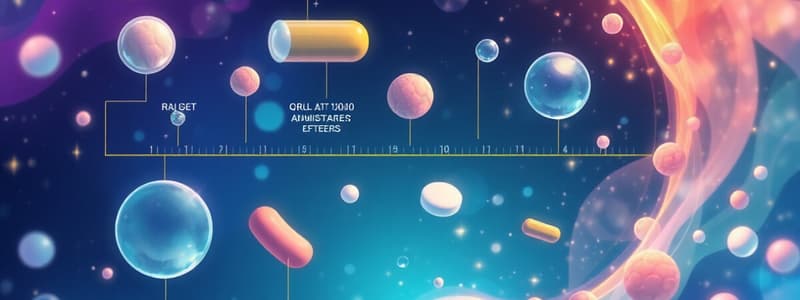Podcast
Questions and Answers
Which of the following is NOT a parenteral route of administration?
Which of the following is NOT a parenteral route of administration?
- IV (intravenous)
- IM (intramuscular)
- Oral (correct)
- SC (subcutaneous)
What is the primary difference between the enteral and parenteral routes of administration?
What is the primary difference between the enteral and parenteral routes of administration?
- The enteral route uses injections, while the parenteral route uses oral ingestion.
- The enteral route uses the gastrointestinal tract, while the parenteral route does not. (correct)
- The enteral route is faster, while the parenteral route is slower.
- The enteral route is used for liquids, while the parenteral route is used for solids.
Which of these dosage forms is NOT typically associated with the enteral route of administration?
Which of these dosage forms is NOT typically associated with the enteral route of administration?
- Solutions
- Capsules
- Tablets
- Patches (correct)
What does the pharmacokinetic phase of drug action primarily focus on?
What does the pharmacokinetic phase of drug action primarily focus on?
Which route of administration utilizes a patch applied to the skin?
Which route of administration utilizes a patch applied to the skin?
Which of the following is NOT a component of the pharmacokinetic phase?
Which of the following is NOT a component of the pharmacokinetic phase?
What is the primary function of the liver in pharmacokinetics?
What is the primary function of the liver in pharmacokinetics?
What does the L/T ratio quantify?
What does the L/T ratio quantify?
Which of the following factors can increase the L/T ratio?
Which of the following factors can increase the L/T ratio?
What is the primary difference between a drug agonist and a drug antagonist?
What is the primary difference between a drug agonist and a drug antagonist?
Which of these scenarios describes an example of synergism in drug interactions?
Which of these scenarios describes an example of synergism in drug interactions?
Which of these is a TRUE statement about the pharmacodynamic phase?
Which of these is a TRUE statement about the pharmacodynamic phase?
Which of these is NOT an example of a potential drug interaction?
Which of these is NOT an example of a potential drug interaction?
Flashcards
Routes of Administration
Routes of Administration
The pathways for a drug to enter the body, like oral or injectable.
Enteral
Enteral
A route where drugs are administered through the GI tract, like tablets and capsules.
Parenteral
Parenteral
Drug administration by methods other than the intestines, primarily via injection.
Transdermal
Transdermal
Signup and view all the flashcards
Pharmacokinetic Phase
Pharmacokinetic Phase
Signup and view all the flashcards
Absorption
Absorption
Signup and view all the flashcards
Distribution
Distribution
Signup and view all the flashcards
Metabolism
Metabolism
Signup and view all the flashcards
Elimination
Elimination
Signup and view all the flashcards
Local Effects
Local Effects
Signup and view all the flashcards
Systemic Effects
Systemic Effects
Signup and view all the flashcards
L/T Ratio
L/T Ratio
Signup and view all the flashcards
Study Notes
Drug Administration Routes
- Routes of administration define the entry point of a drug into the body (e.g., oral, injectable, inhalation).
- Enteral routes use the gastrointestinal tract (GI). Examples include tablets, capsules, suppositories, elixirs, and suspensions.
- Parenteral routes administer drugs outside the GI tract. Common methods are intravenous (IV), intramuscular (IM), subcutaneous (SC), intrathoracic (IT), intraosseous (IO).
- Transdermal routes use patches or pastes to deliver drugs through the skin.
- Inhalation routes introduce drugs in gas, mist, aerosol, or dust form.
- Topical routes apply drugs as powders, lotions, or ointments directly to the affected area.
Drug Dosage Forms
- Drug dosage form describes the physical state of the drug and associated non-drug components.
- Examples include tablets, capsules, and solutions.
Pharmacokinetic Phase
- Pharmacokinetic phase describes the drug's time course and disposition in the body, focusing on absorption, distribution, metabolism, and elimination.
- Absorption: How drugs enter the bloodstream.
- Distribution: Drug movement to sites of action, elimination, or storage.
- Metabolism: Drug transformation (often in the liver) into active forms.
- Elimination: Removal of the drug from the body (often by the kidneys).
Local vs. Systemic Effects
- Local effects target a specific area.
- Systemic effects circulate throughout the body.
L/T Ratio
- L/T ratio (Lung/Total) represents the proportion of drug reaching the lungs compared to systemic availability (via all routes).
- Formula: Lung dose / (Lung dose + GI dose).
- Factors increasing the L/T ratio include efficient delivery devices, inhaled drugs with high first-pass metabolism, and mouth rinsing/spitting.
Pharmacodynamic Phase
- Pharmacodynamic phase describes how drugs act on the body—the drug's mechanism and effect on body systems.
Structure-Activity Relationships
- Structure-activity relationships explore the connection between a drug's chemical structure and its effect on the body.
Drug Receptor Interactions
- Receptor: A cell component that combines with a drug, affecting or enhancing the cell's function.
- Agonist: Drug that binds to a receptor and initiates a response.
- Antagonist: Drug that binds to a receptor but does NOT elicit a response; it blocks the receptor.
Drug Interactions
- Synergism: Combined drug effects exceeding the sum of their individual effects.
- Additivity: Two drugs with similar actions produce combined effects equal to their individual effects.
- Potentiation: One drug with no effect enhances the action of another.
Studying That Suits You
Use AI to generate personalized quizzes and flashcards to suit your learning preferences.




